Discovering the Significance of Fixing a Broken Faucet
ContactDo you find yourself in search of content on Should I Repair or Replace a Leaky Faucet??

Leaking faucets may appear like a small trouble, yet their influence surpasses simply the nuisance of the sound. From wasting water to sustaining unneeded economic prices and wellness threats, neglecting a leaking faucet can lead to numerous repercussions. In this short article, we'll delve into why it's crucial to resolve this typical household concern immediately and efficiently.
Wastefulness of Water
Ecological Impact
Leaking faucets contribute dramatically to water waste. According to the Epa (EPA), a single tap dripping at one drip per secondly can waste more than 3,000 gallons of water each year. This not only stress water sources but additionally affects ecological communities and wildlife based on them.
Financial Prices
Raised Water Costs
Past the ecological influence, dripping taps can blow up water expenses considerably. The gathered wastefulness with time converts right into greater utility costs, which might have been prevented with timely repair services.
Prospective Property Damages
In addition, extended leaking can lead to harm to fixtures and surfaces bordering the faucet. Water buildup can trigger discoloration, rust, and even architectural issues if left ignored, causing extra fixing expenses.
Wellness Issues
Mold And Mildew and Mildew Growth
The consistent presence of wetness from a trickling faucet develops an optimal setting for mold and mildew and mildew growth. These fungi not just endanger interior air quality but additionally pose health and wellness threats, particularly for people with respiratory system conditions or allergies.
Waterborne Conditions
Stationary water in dripping faucets can end up being a breeding place for microorganisms and other microorganisms, raising the threat of waterborne diseases. Contaminants such as Legionella bacteria thrive in stagnant water, potentially leading to serious illnesses when ingested or breathed in.
DIY vs. Professional Repair work
Advantages and disadvantages of DIY Repair Work
While some may try to take care of a leaking faucet themselves, do it yourself repair work feature their own set of difficulties. Without correct knowledge and devices, DIY efforts can intensify the problem or lead to insufficient repairs, extending the trouble.
Benefits of Employing a Specialist Plumber
Working with an expert plumber makes certain that the underlying cause of the dripping faucet is attended to properly. Plumbings possess the competence and devices to identify and repair faucet issues successfully, conserving time and lessening the danger of further damage.
Step-by-Step Overview to Taking Care Of a Dripping Faucet
Tools Called for
Prior to attempting to fix a trickling tap, collect the required devices, consisting of an adjustable wrench, screwdrivers, substitute parts (such as washing machines or cartridges), and plumber's tape.
Typical Tap Issues and Their Solutions
Determine the type of tap and the certain issue triggering the drip. Common problems consist of damaged washers, corroded shutoff seats, or defective O-rings. Refer to supplier instructions or on-line tutorials for step-by-step guidance on fixings.
Safety nets
Regular Upkeep Tips
To prevent trickling faucets, do regular upkeep such as cleaning up aerators, inspecting for leakages, and replacing damaged parts quickly. In addition, think about mounting water-saving devices or upgrading to much more effective components.
Importance of Prompt Repair Works
Resolving trickling faucets as soon as they're discovered stops more water wastefulness and possible damages, ultimately conserving both water and money in the long run.
Effect On Property Worth
Understanding of Well-Maintained Home
Keeping a property in good condition, consisting of dealing with maintenance issues like trickling taps, boosts its perceived value and value among prospective purchasers or lessees.
Impact on Resale Value
Qualities with properly maintained plumbing fixtures, including faucets, command higher resale values in the real estate market. Attending to leaking taps can add to a favorable impact during residential property examinations and negotiations.
Environmental Responsibility
Individual Payment to Preservation
Taking obligation for dealing with trickling taps lines up with broader initiatives toward water preservation and environmental sustainability. Every individual's actions collectively make a significant impact on maintaining valuable resources.
Lasting Living Practices
By focusing on prompt repair services and adopting water-saving routines, individuals add to sustainable living methods that profit both present and future generations.
Verdict
Dealing with a dripping tap goes beyond mere benefit; it's an essential action towards saving water, reducing financial prices, and safeguarding wellness and building. Whether through do it yourself repairs or expert aid, taking action to deal with leaking taps is a small yet impactful way to advertise accountable stewardship of resources and add to a healthier, more lasting future.
How to Fix a Dripping or Leaky Faucet
A leaking faucet is one of the most common problems that homeowners encounter, but it being commonplace doesn’t make it any less annoying. The constant drip drip drip of a leaking bathtub faucet, showerhead, or sink tap can disturb your home’s serenity. Left neglected, a dripping faucet can also result in higher water bills and discoloration or mold growth in your sink or plumbing fixtures.
Fortunately, you don’t have to be a trained plumber to know how to stop a dripping faucet. With some basic tools, replacement parts, and a little patience, leaky faucet repair is a breeze. In this article, we’ll explain what causes dripping faucets and how you can fix them.
What Causes a Leaking Faucet?
Kitchen and bathroom faucets come in all manner of designs, but most involve some combination of valves, O-rings, seals, and washers. The O-ring is usually the weakest link, but any one of these pieces can wear down over time. Heat, moisture, temperature fluctuations, minerals, mold, and movement can contribute to warping and corrosion, breaking the watertight seal. This just comes with the territory of being a homeowner. Everything is always subject to wear and tear, and some component parts of your appliances and fixtures need to be replaced on occasion. At least replacement O-rings are cheap!
More rarely, dripping faucets can be a symptom of excessively high water pressure. Were this the case in your home, you would probably notice that the leak is not isolated to one faucet. Water pressure issues are harder to resolve on your own. We recommend contacting a professional plumber if you suspect your water pressure is too high.
How to Fix a Dripping Faucet
Pipe wrench or monkey wrench Allen wrench set Screwdrivers Old towel or rag Shut off the water.
Before you do anything, you need to turn off the water to keep from drenching your kitchen or bathroom. You should find a valve under the sink and against the wall. Once you’ve turned this valve, try turning the faucet on to confirm that the water source has been cut off.
If you can’t locate your local valve for the faucet you’re working on, you can always shut off the water to the house at the main valve. Of course, this will prohibit anyone from using the sinks, showers, or toilets while you’re working on the faucet that’s giving you trouble.
Plug or block the drain.
You’ll be disassembling the faucet and removing some small bits of hardware. Plug the drain with a stopper or rag to avoid the possibility of a small screw falling into your P-trap.
Take apart the faucet assembly.
There are several varieties of kitchen and bathroom faucets, each with its own manner of assembly. For detailed instructions on how to disassemble your faucet, you can refer to the fixture’s manual or contact the manufacturer. If you know whether you have a ball, disc, cartridge, or compression faucet, you can find detailed schematics online.
In general, you need to begin by removing the faucet handles. You might notice a small screw that you’ll need to remove with a screwdriver or Allen wrench. If you don’t see any visible securing hardware, it’s likely hidden under a decorative cap that can be unscrewed or popped off with flathead screwdriver.
Remove each piece methodically, consulting a schematic when necessary. Take notes or arrange the pieces in such a way to make it easier to correctly reassemble the faucet later.
Remove the cartridge.
Once you’ve removed the handles and securing hardware, you should be able to remove the valve cartridge or stem. Some cartridges will slide right out. Other faucet models will require you to loosen a nut with a pipe wrench before you can remove the valve stem.
Examine the exposed hardware.
With the cartridge or stem removed, inspect the component parts. Check the rubber O-rings for wear and tear. Also examine the seat washer for corrosion or other damage. These pieces are usually the responsible parties for a dripping faucet, but it’s worth inspecting the other component parts while you have the faucet disassembled.
Find replacement parts.
Once you’ve identified which faucet component has failed, find an identical replacement. Your local hardware store should have O-rings, seat washers, and other standard components in stock. If you have a luxury or uncommon faucet, you may have to contact the manufacturer for a replacement part.
It’s a good idea to take your old parts with you to the hardware store so you can compare them with the store’s inventory and be sure you’re purchasing the correct replacement.
Reassemble the faucet.
With your new parts in hand, reconstruct the faucet and handles. Don’t be tempted to overtighten screws or nuts. You might think this could create a better seal, but it can instead damage or bend a delicate part of the assembly and create a new problem for you.
Turn on the water and test the faucet.
The only thing left to do is test your work. Unplug the sink, turn the water back on, and try the faucet. Congratulate yourself on a job well done!
https://www.libertyhomeguard.com/how-to-fix-a-dripping-or-leaky-faucet/

We were introduced to that write-up about Why It's Important to Fix Leaky Faucets through a pal on our other site. Remember to take the opportunity to promote this write-up if you enjoyed reading it. Thank-you for going through it.